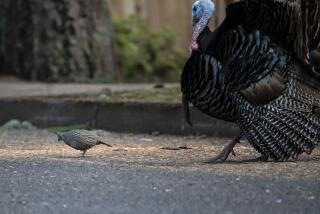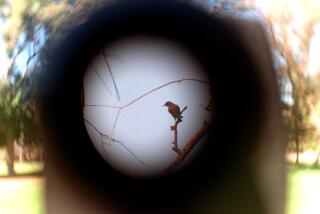In Tourist-Hungry Town, Hope Is the Thing With Feathers
BRINKLEY, Ark. â This time of year, ducks flock by the hundreds to the Cache River National Wildlife Refuge, where bands of white-tailed deer graze under a canopy of 1,000-year-old trees. Near a cypress swamp, the sun warms the autumn air, making this bottomland a paradise for wild turkeys, foraging squirrels and insects the size of kumquats.
Somewhere in the wilderness probably lives a bird -- or birds -- once thought extinct: the ivory-billed woodpecker, with its 30-inch wingspan and distinctive white stripes on a coal-black body.
When Cornell University ornithologists announced in April that the ivory-bill -- the largest woodpecker in North America -- had been rediscovered, bird lovers worldwide rejoiced.
And here in Monroe County, where a quarter of residents live in poverty, merchants stocked up on bird-related souvenirs and waited for tourists.
But with fresh sightings of the ivory-bill yet to be confirmed, âweâre still waiting for the tourist part,â hairdresser Penny Childs said.
Outside her salon, woodpecker T-shirts hang from a tree, swinging in the breeze. Inside, about half of the establishment has been taken over with woodpecker souvenirs: candles, artwork, books. Childs, who has a smock embroidered with the nickname âPeckerwood Penny,â has created the $25 âwoodpeckerâ haircut -- a spiked hairdo accented with red, black and white paint.
âItâs like waiting for Christmas to get here,â Childs said of what residents hoped would be a big winter bird-watching season.
Folks here knew that few visitors would brave the mosquitoes, snakes and wilting heat of an Arkansas summer to look for the bird, said Larry E. Mallard, manager of the White River National Wildlife Refuge, where ornithologists taped what is believed to be the ivory-billâs call. Better to wait until the dead of winter, he said, when the dense foliage has dropped and there is a better chance of spotting the skittish bird or hearing its signature rap -- a loud double-knock: BAM-bam!
The changing season has brought a second round of Cornell biologists to the woods of eastern Arkansas, camcorders and binoculars in tow. For the next six months, the team -- aided by volunteers and possibly decoys and audiotapes to attract the ivory-bill -- will comb 550,000 acres of forest and swampland. One objective is to photograph the bird so there is no question about its identity.
If, as a bonus, searchers find a roost or nest hole, âthat would be unbelievably thrilling,â Cornell project spokeswoman Connie Bruce said.
The initial search for the ivory-bill, launched in March 2004, was conducted in such secrecy that the bird was given a code name: Elvis. Participants were asked to sign confidentiality agreements. This time, with the bird out of the bag, most everyone in Brinkley knows the scientists are back for another look. And the team will be publicizing its work with a âmedia dayâ for reporters in December.
Ivory-billed woodpeckers once roamed forests across the South, feeding by peeling the bark off trees to reach insects underneath. Their numbers dwindled as forests were cut for lumber and cleared for farming.
The last confirmed sighting, before Aprilâs announcement, was in 1944 in Louisiana.
In February 2004, a kayaker floating down a stream in the Cache River National Refuge spotted the bird. That led to an intensive, yearlong search that yielded multiple credible sightings and a grainy four-second video of what is believed to be the ivory-bill in flight.
Some here wish the bird had stayed hidden.
Resident Sam Gillam, 22, worries that curious humans will upset a delicate balance of nature that allowed the ivory-bill to survive, unobserved, for decades. âHe was back here all those years by himself,â Gillam said. âHe was doing something right. When you get a lot of people looking for him, something might happen to change where he lives, or people might just scare him off. I think they should just leave him alone.â
Others grumble that federal and state laws meant to protect the rare bird might interfere with deer hunting and duck hunting in the area. âPeople were raised here and hunted here all their lives,â said Billie Henry, 58. âThere will be hard feelings if they have to change what theyâre used to. Older people, especially, are set in their ways -- theyâre serious about hunting.â
But many others in town donât see how anything but good can come from the celebrity bird.
âIf people want to come all the way out here to look for a woodpecker, we welcome them. Anytime people come and spend money, that helps the town,â restaurant owner Gene DePriest said. DePriest, 69, has done his part, honoring the bird with an ivory-billed salad (chicken with sesame seeds) and an ivory-billed burger (served on a sesame bun). âThe Bird is the Word,â a sign in his parking lot says.
Other nearby communities also have tried to make visitors feel welcome. Hunting lodges have expanded services to include canoe trips for birders. A Super 8 Motel is now the Ivory-Bill Inn. Crews at the refuge have trimmed hanging branches to make way for tour buses. New signs detailing the markings of the ivory-bill -- and of the similar but common pileated woodpecker -- have been posted along birding trails.
All thatâs needed now is another confirmed ivory-bill sighting and a photograph in sharp focus, Mallard said.
Not everyone is convinced that the bird exists, believing that the blurry video actually shows the pileated variety.
âItâs absolutely necessary to get a better video, a clear still shot, sightings that are irrefutable,â Mallard said. âIf that were to happen or letâs say you found a roost tree, youâd see the kind of interest youâve never seen before.
âIt would show that Elvis is in the building.â
More to Read
Sign up for The Wild
Weâll help you find the best places to hike, bike and run, as well as the perfect silent spots for meditation and yoga.
You may occasionally receive promotional content from the Los Angeles Times.






